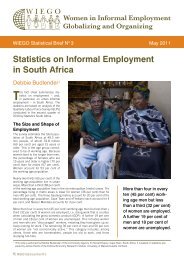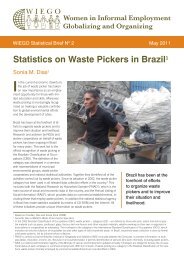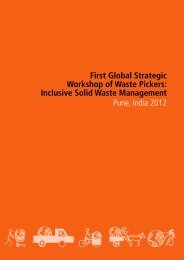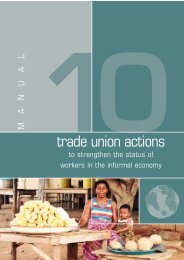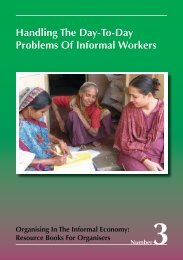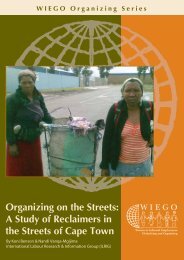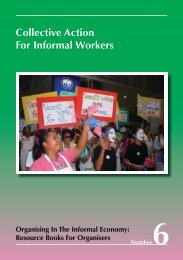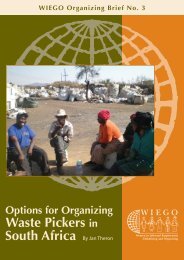Informal Economy Budget Analysis in Philippines and ... - WIEGO
Informal Economy Budget Analysis in Philippines and ... - WIEGO
Informal Economy Budget Analysis in Philippines and ... - WIEGO
Create successful ePaper yourself
Turn your PDF publications into a flip-book with our unique Google optimized e-Paper software.
<strong>WIEGO</strong> Work<strong>in</strong>g Paper N o 12determ<strong>in</strong>ed by the government, or those who cannot afford to provide <strong>in</strong> a susta<strong>in</strong>ed manner for theirm<strong>in</strong>imum basic needs for food, health, education, hous<strong>in</strong>g <strong>and</strong> other social amenities <strong>in</strong> life. 3Unemployment (estimated at 7.7 percent <strong>and</strong> underemployment at 18.2 percent) based on the January 2009Labour Force Survey (LFS) released by the National Statistics Office (NSO) reflect the current employmentcrisis. There were more males (64.1%) than females (35.9%) among the total unemployed but this could,<strong>in</strong> part, reflect the fact that many women who are not employed will classify themselves as ‘housewives’ <strong>and</strong>thus out of the labour force, while this option is not available for most men. The <strong>in</strong>creas<strong>in</strong>g number of joblessmales is an emerg<strong>in</strong>g concern <strong>and</strong> its gender ramifications warrant closer exam<strong>in</strong>ation.The actual poverty <strong>in</strong>cidence may even be higher than reported above s<strong>in</strong>ce those without official <strong>and</strong>permanent residences – among them, the ambulant, pushcart-dwell<strong>in</strong>g masses – are not counted <strong>in</strong> thegovernment’s poverty mapp<strong>in</strong>g. Moreover, comparisons across prov<strong>in</strong>ces would show wide disparities <strong>and</strong>uneven progress. While poverty <strong>in</strong> urban areas is on the rise, poverty <strong>in</strong> the Philipp<strong>in</strong>es rema<strong>in</strong>s a largelyrural phenomenon due to the sluggish growth of the agricultural sector. Seventy three percent of thecountry’s poor reside <strong>in</strong> rural areas.Several studies (for example, ADB, 2005) po<strong>in</strong>t to the follow<strong>in</strong>g as the major causes of poverty <strong>in</strong> thePhilipp<strong>in</strong>es: a) weak macroeconomic management; b) high population growth rates; c) employmentproblems; d) poor governance, <strong>in</strong>clud<strong>in</strong>g corruption <strong>and</strong> electoral fraud; e) an underperform<strong>in</strong>g agriculturalsector <strong>and</strong> an uncompleted l<strong>and</strong> reform agenda; <strong>and</strong> f) security <strong>and</strong> conflict issues, particularly <strong>in</strong>M<strong>in</strong>danao. Experts also contend that the perennially low public spend<strong>in</strong>g <strong>in</strong> poverty reduction programmes<strong>in</strong> terms of improv<strong>in</strong>g the people’s access to basic social services, assets, <strong>and</strong> physical <strong>in</strong>frastructures, isthe reason for the persistence of poverty <strong>in</strong> the country.Jobless growth <strong>and</strong> the <strong>in</strong>formalisation of women’s workIn the Philipp<strong>in</strong>e labour market, jobless growth has <strong>in</strong>tensified problems of unemployment, with morejobless men <strong>and</strong> unemployed youth than before. Men’s joblessness is driv<strong>in</strong>g more women actively tolook for work as evidenced by their higher labour force participation rates <strong>and</strong> a trend whereby previouslyunpaid female family workers <strong>in</strong> family <strong>in</strong>come-earn<strong>in</strong>g activities now look for paid jobs <strong>and</strong> engage asdomestic helpers or <strong>in</strong>formal workers. (Lazo, 2008: 18–26)Over the last ten years, an <strong>in</strong>creas<strong>in</strong>g number of women have been discover<strong>in</strong>g their way <strong>in</strong>to <strong>in</strong>formalemployment. These figures are substantiated further by the research f<strong>in</strong>d<strong>in</strong>gs of Lucila S. Lazo based ondata gathered from the Institute of Labour Studies (ILS), where ‘the percentage of <strong>in</strong>formal women workersrose from 39 percent <strong>in</strong> 1996 to 42 percent <strong>in</strong> 2001, <strong>and</strong> <strong>in</strong> 2006, figures hovered around 49 percent.’ 4Lazo’s paper also reaffirms the results of the CEDAW report, stat<strong>in</strong>g that:A large portion of the growth <strong>in</strong> <strong>in</strong>formal employment has come from women <strong>in</strong> self-employment....Asheavily protected <strong>in</strong>dustries collapsed s<strong>in</strong>ce 1996, workers who were laid off from their formal sector jobssought refuge <strong>in</strong> self-employment, provid<strong>in</strong>g them a means of economic support….<strong>Informal</strong> sector workprovides a measure of flexibility especially for women <strong>in</strong> that they are able to engage <strong>in</strong> productive tasks<strong>and</strong> such livelihood activities as vend<strong>in</strong>g or hawk<strong>in</strong>g, operat<strong>in</strong>g small eateries or stores, laundry or sew<strong>in</strong>g athome....However, <strong>in</strong> this sector, work is often physically exhaust<strong>in</strong>g or uncomfortable <strong>and</strong> <strong>in</strong>come is usuallylow or irregular...Work <strong>in</strong> the <strong>in</strong>formal sector also perpetuates the multiple burdens of women. (Quoted <strong>in</strong>Lazo, 2007:27)3From the presentation of NSCB Secretary-General Romulo Virola, dur<strong>in</strong>g the Press Conference on the Poverty Statistics, sourced atwww.pcij.org/blog/wp-docs/NSCB_Poverty_2006.pdf4To provide an estimate, figures were derived by add<strong>in</strong>g unpaid family workers <strong>and</strong> the own account workers.3




